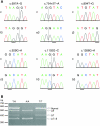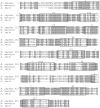The novel neuronal ceroid lipofuscinosis gene MFSD8 encodes a putative lysosomal transporter
- PMID: 17564970
- PMCID: PMC1950917
- DOI: 10.1086/518902
The novel neuronal ceroid lipofuscinosis gene MFSD8 encodes a putative lysosomal transporter
Abstract
The late-infantile-onset forms are the most genetically heterogeneous group among the autosomal recessively inherited neurodegenerative disorders, the neuronal ceroid lipofuscinoses (NCLs). The Turkish variant was initially considered to be a distinct genetic entity, with clinical presentation similar to that of other forms of late-infantile-onset NCL (LINCL), including age at onset from 2 to 7 years, epileptic seizures, psychomotor deterioration, myoclonus, loss of vision, and premature death. However, Turkish variant LINCL was recently found to be genetically heterogeneous, because mutations in two genes, CLN6 and CLN8, were identified to underlie the disease phenotype in a subset of patients. After a genomewide scan with single-nucleotide-polymorphism markers and homozygosity mapping in nine Turkish families and one Indian family, not linked to any of the known NCL loci, we mapped a novel variant LINCL locus to chromosome 4q28.1-q28.2 in five families. We identified six different mutations in the MFSD8 gene (previously denoted "MGC33302"), which encodes a novel polytopic 518-amino acid membrane protein that belongs to the major facilitator superfamily of transporter proteins. MFSD8 is expressed ubiquitously, with several alternatively spliced variants. Like the majority of the previously identified NCL proteins, MFSD8 localizes mainly to the lysosomal compartment. However, the function of MFSD8 remains to be elucidated. Analysis of the genome-scan data suggests the existence of at least three more genes in the remaining five families, further corroborating the great genetic heterogeneity of LINCLs.
Figures





References
Web Resources
-
- BLAST, http://www.ncbi.nlm.nih.gov/BLAST/ (for NCBI protein-protein BLAST)
-
- FlyBase, http://flybase.bio.indiana.edu/
-
- GenBank, http://www.ncbi.nlm.nih.gov/Genbank/ (for MFSD8 [accession number NM_152778])
-
- HMMTOP, http://www.enzim.hu/hmmtop/
-
- MAFFT version 5.8, http://align.bmr.kyushu-u.ac.jp/mafft/online/server/
Publication types
MeSH terms
Substances
Associated data
- Actions
LinkOut - more resources
Full Text Sources
Other Literature Sources
Medical
Molecular Biology Databases
Miscellaneous

